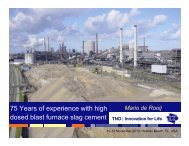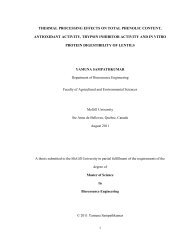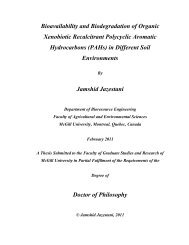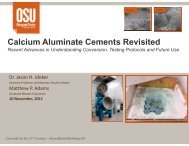Postharvest treatments to reduce chilling injury symptoms in stored ...
Postharvest treatments to reduce chilling injury symptoms in stored ...
Postharvest treatments to reduce chilling injury symptoms in stored ...
Create successful ePaper yourself
Turn your PDF publications into a flip-book with our unique Google optimized e-Paper software.
condition, off-flavor and sk<strong>in</strong> discoloration of fruits will occur (Hat<strong>to</strong>n and Reeder,<br />
1966).<br />
The basic idea of Controlled Atmosphere S<strong>to</strong>rage (CA) is <strong>to</strong> ma<strong>in</strong>ta<strong>in</strong> the best<br />
product quality. This can be accomplished by keep<strong>in</strong>g CO2, O2 and Ethylene gases at<br />
predeterm<strong>in</strong>ed levels (gas levels differ depend<strong>in</strong>g on the type of fruit be<strong>in</strong>g s<strong>to</strong>red).<br />
Usually decreased O2 and <strong>in</strong>creased CO2 levels at a low temperature with high RH are<br />
suitable for s<strong>to</strong>red commodities. CA can provide an effective s<strong>to</strong>rage environment for<br />
different fruits and vegetables (Raghavan et al., 2003, 1984; Bender et al., 2000; Gariépy<br />
and Raghavan, 1991, 1986, 1984; Kader 1986).<br />
Modified atmosphere (MA) is referred <strong>to</strong> as a relationship between product<br />
respiration and gas exchange with<strong>in</strong> any form of structural enclosure. MA s<strong>to</strong>rage<br />
technique can be used <strong>to</strong> ma<strong>in</strong>ta<strong>in</strong> the postharvest quality of different fruits (D<strong>in</strong>g et al.,<br />
2002; Rodov et al., 2002; Meir et al., 1998; Illeperuma and Jayasuriya, 2002; Prabhanjan<br />
et al., 1992). MA packag<strong>in</strong>g <strong>in</strong>hibited the mango ripen<strong>in</strong>g process (Sornsrivichai et al.,<br />
1989, 1992). In 1994, Yantarasri et al., found that film perforation delay soften<strong>in</strong>g and<br />
can <strong>reduce</strong> the weight loss of mango cv. Nam Doc Mai.<br />
Diffusion channel method is a system where gas diffuses <strong>in</strong> a s<strong>to</strong>rage chamber,<br />
through a tube, that connects the ambient air with the chamber atmosphere. Several<br />
researchers (Ratti et al., 1998; Baugerod, 1980; Ramachandra, 1995) have successfully<br />
demonstrated that by us<strong>in</strong>g diffusion channels the gas exchange capability and the<br />
ma<strong>in</strong>tenance of equilibrium O2 level can be achieved over a long period of time. The<br />
advantage of these systems is that pressure and temperature fluctuations do not<br />
significantly affect the system. It should be noted that studies related <strong>to</strong> mango s<strong>to</strong>rage<br />
us<strong>in</strong>g diffusion channels is not available <strong>in</strong> the literature. There is scope <strong>to</strong> study this<br />
technique for extend<strong>in</strong>g shelf life of mangoes.<br />
2.2.3 S<strong>to</strong>rage at low pressure<br />
Low pressure s<strong>to</strong>rage, also called hypobaric s<strong>to</strong>rage, deals with the control of air<br />
pressure, temperature and humidity. The ma<strong>in</strong> pr<strong>in</strong>ciple of low pressure is that the<br />
pressure of the chamber is directly proportional <strong>to</strong> the O2 level. With a pressure decrease,<br />
the amount of O2 decreases reduc<strong>in</strong>g the respiration rate of the product. This system easily<br />
11









